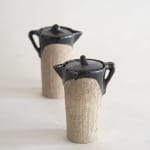





Raku Tannyû (1795–1854)
Sake Warmers (called Chirori), circa 1830's
Fired clay with glaze
5 1/2'' x 2 1/2"
Sold
Further images
These objects are a set of sake warming decanters crafted by Raku Tannyu (1795-1854), of the esteemed Raku family in Kyoto; on the bottom lies the stamp of the 10th...
These objects are a set of sake warming decanters crafted by Raku Tannyu (1795-1854), of the esteemed Raku family in Kyoto; on the bottom lies the stamp of the 10th generation of Raku potters. For use, they were secured by a metal insert set in a pot and only partially submerged into boiling water, and later lifted from place to transfer their heated sake to a drinking cup.
They are such humble, soulful objects. In the tradition of the Raku family, Raku Tannyu sculpted them only with his hands (without using potter's wheel) , taking care to form each of their tiny handles and spouts. Just notice, for example, the way in which each lid fits perfectly under the overhanging edge of the handle, or imagine the feeling of running one’s thumb from the rough body of combed clay towards the object’s smooth crest of chocolate glaze. These tiny details reveal Raku Tannyu’s acute aesthetic sensitivity to the balance between texture, form, and color. Small and unpretentious as they are, these sake warmers offer rich pleasure to the hand and eye alike.
An inventive soul will see many possibilities in this pair of objects; whether as vessels for warm sake, or perhaps oil and vinegar for the modern table. Regardless of use, the sake warmers will always satiate an open mind.
They are such humble, soulful objects. In the tradition of the Raku family, Raku Tannyu sculpted them only with his hands (without using potter's wheel) , taking care to form each of their tiny handles and spouts. Just notice, for example, the way in which each lid fits perfectly under the overhanging edge of the handle, or imagine the feeling of running one’s thumb from the rough body of combed clay towards the object’s smooth crest of chocolate glaze. These tiny details reveal Raku Tannyu’s acute aesthetic sensitivity to the balance between texture, form, and color. Small and unpretentious as they are, these sake warmers offer rich pleasure to the hand and eye alike.
An inventive soul will see many possibilities in this pair of objects; whether as vessels for warm sake, or perhaps oil and vinegar for the modern table. Regardless of use, the sake warmers will always satiate an open mind.





